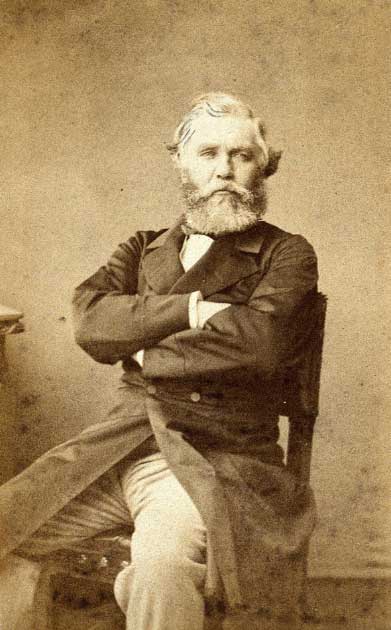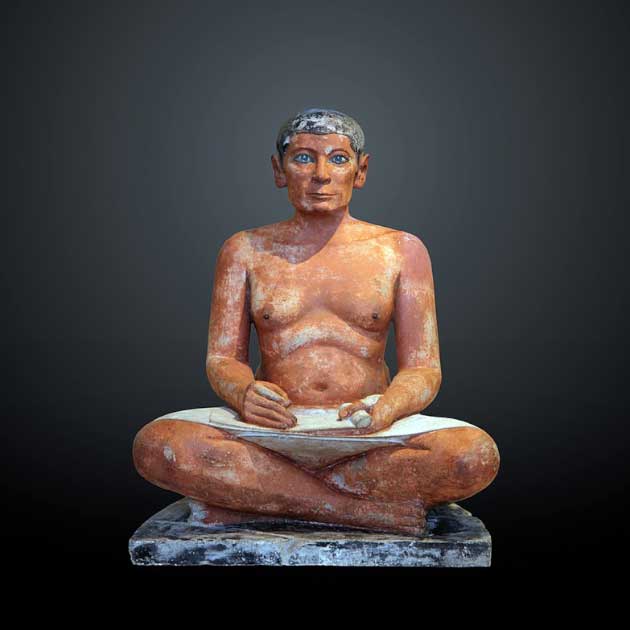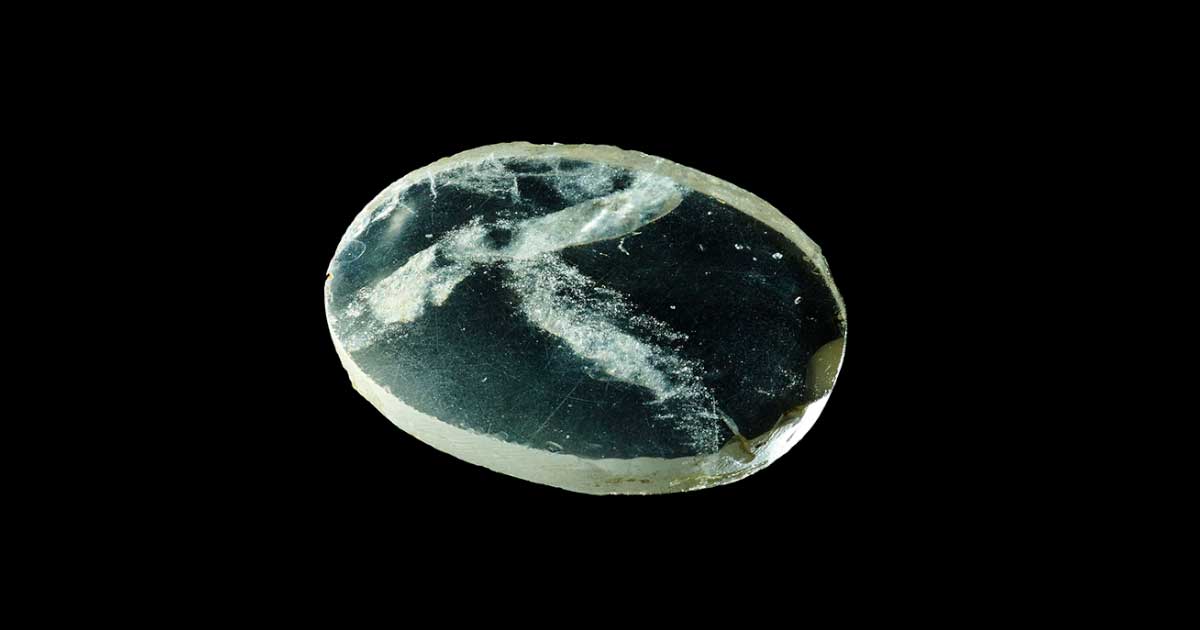Is the Assyrian Nimrud Lens the Oldest Telescope in the World?
The Nimrud lens is a 3,000-year-old piece of rock crystal unearthed by Sir John Layard in 1850 at the Assyrian palace of Nimrud, in modern-day Iraq. Since its discovery over a century ago, scientists and historians have debated its use, with one prominent Italian professor claiming the lens was used by the ancient Assyrians as part of a telescope. This was used to explain how the Assyrians knew so much about astronomy.

The Nimrud lens. (The British Museum / CC BY-NC-SA 4.0)
Understanding the Nimrud Lens Artifact
The Nimrud lens (also called the Layard lens), which has been dated to between 750 and 710 BC, is made from natural rock crystal and is a slightly oval in shape. It was roughly ground, perhaps on a lapidary wheel. It has a focal point about 11 centimeters (4.33 in) from the flat side, and a focal length of about 12 cm (4.72 in).
- Glass Shard Found at Japanese Shrine Matches Artifacts from Persian Royal Palace
- The Beautiful and Complex Artisanship of Glass-making in the Ancient World
These dimensions would make the Nimrud lens equivalent to a 3× magnifying glass. Combined with another lens, it could achieve much greater magnification. The surface of the lens was created with twelve cavities that were opened during grinding. These would have contained naptha or some other fluid trapped in the raw crystal. The lens is said to be able to focus sunlight, although the focus is far from perfect.

Sir Austen Henry Layard, the English Assyriologist who directed the excavations of Nimrud, where the Nimrud lens was unearthed in 1850. (Public domain)
The British Museum and the Nimrud Lens
There has been much debate over the original use of the Nimrud lens. Some speculate that it was used as a magnifying glass, or as a burning-glass to start fires by concentrating sunlight, while others have proposed that the lens was part of a telescope. However, if we are to believe the British Museum’s description, the Nimrud lens “would have been of little or no practical use.”
While they acknowledge that “this piece of rock crystal has been carefully ground and polished, and undoubtedly has optical properties,” they reach the unusual conclusion that the optical properties were “probably accidental.” I wonder if the British Museum also maintains that the hundreds of other carefully crafted and polished lenses found throughout the ancient world were also “accidental”?
In their description, the British Museum concludes by saying that: “There is no evidence that the Assyrians used lenses, either for magnification or for making fire, and it is much more likely that this is a piece of inlay, perhaps for furniture.” However, many disagree with this claim.

1859 image from page 323 of "Discoveries among the ruins of Nineveh and Babylon; with travels in Armenia, Kurdistan and the desert: being the result of a second expedition undertaken for the Trustees of the British museum" by Austen Henry Layard. (Public domain)
Hypotheses for the Purpose of the Nimrud Lens
Layard suggested that Assyrian craftsmen used the lens as a magnifying glass to make intricate and miniscule engravings, such as those that have been found on seals and on clay tablets using a wedge-shaped script. But experts on Assyrian archaeology have remained unconvinced. They have claimed that the Nimrud lens is of such low quality that it would have been a poor aid to vision.
Another hypothesis is that the lens was used as a burning glass to start fire. Burning-glasses were known in the ancient world. Aristophanes referred to “the beautiful, transparent stone with which they light fires” in his play The Clouds (424 BC). Meanwhile, Pliny the Elder (23 to 79 AD) described how glass balls filled with water could set clothes on fire when placed in line with the sun. However, there is no clear evidence to support the theory that this was the purpose for which the Nimrud lens was created.
Italian scientist Giovanni Pettinato of the University of Rome has proposed that the lens was used by the ancient Assyrians as part of a telescope. According to conventional perspectives, the telescope was invented by Dutch spectacle maker, Hans Lippershey in 1608 AD, and Galileo was the first to point it to the sky and use it to study the cosmos. But even Galileo himself noted that the so-called “ancients” were aware of telescopes.

The Seated Scribe, or Le Scribe Accroupi, is an ancient Egyptian artwork which represents a seated scribe at work. Its eyes are inlaid with rock crystal and are one of the first examples of lenses discovered to date. (Rama / CC BY-SA 3.0 FR)
While lenses were around before the Nimrud lens, Pettinato believed this was one of the first to be used in a telescope. The earliest lenses to have been identified so far date back around 4,500 years to the 4th and 5th Dynasties of ancient Egypt (e.g. the superb Le Scribe Accroupi, or Seated Scribe, and the Kai in the Louvre), where it appears they were used as schematic eye structures (iris/pupil inserts) associated with funerary statues.
Latter examples have been found in Knossos dated to around 3,500 years ago. In total, there are several hundred reported lenses now on record from around the ancient world, so it appears that the ancients knew a lot more about lenses than some, like the British Museum, give them credit for.

View of Saturn. (elen31 / Adobe Stock)
Saturn’s Serpents: Evidence of Assyrian Advanced Astronomy?
One of the reasons Pettinato believed that the Assyrians used the Nimrud lens as part of a telescope is that some of their knowledge about astronomy seems impossible to have acquired without a telescope.
- Crystal-Clear Vision – The Ancient History of Eyeglasses
- Eye-conic Siberian Spectacles: Dazzling Eye Fashion From 2,000 Years Ago Until Today
For example, the ancient Assyrians saw the planet Saturn as a god surrounded by a ring of serpents, which Pettinato suggests was their interpretation of Saturn's rings as seen through a telescope. However, other experts say that serpents occur frequently in Assyrian mythology, and note that there is no mention of a telescope in any of the many surviving Assyrian astronomical writings.
Whatever its purpose, as an ornament, as magnifying lens, a burning glass, or part of a telescope, the Nimrud lens certainly appears to be more than an accident. But exactly how it was used, we may never know.
Top image: The Nimrud lens. Source: The British Museum / CC BY-NC-SA 4.0
By Joanna Gillan
References
BBC. 1 July 1999. “World's oldest telescope?” In BBC News. Available at: http://news.bbc.co.uk/2/hi/380186.stm
No name. No date. “Ancient Lenses” in Ancient Wisdom. Available at: http://www.ancient-wisdom.com/optics.htm
The British Museum. No date. “The Nimrud Lens” in The British Museum. Available at: https://www.britishmuseum.org/collection/object/W_-90959


















Comments
There is ANOTHER thing that could use a crystal lense.. and that is a aser device... The higher energy that could be produced would need a more stable lense than our simple pet toys . Just saying
infinitesimal waveparticles comprise what we call home the earth
manipulatable by thought ability supressed in humans since birth
While it is possible that this lens was used to look at the sky, the imperfections in the lens lead me to believe this might have been used as an optical aid: to help with reading, or looking at small things.
There’s no doubt that the outer edges have been polished, and so has the surface, but again, the imperfections make it unlikely it could have been used for distance astronomy.
"The Nimrud lens (also called the Layard lens), which has been dated to between 750 and 710 BC"
They don't say how, but it was likely relative dating, i.e., based upon the bones and/or other objects at the site. Absolute dating might use radioactive signatures in the material, but they know that’s a can of worms. It could be much older. Being only one or not many of these lenses suggests they were found, not made, and thus a product of the pre-Ice Age megalith stone culture that was wiped out suddenly about 120,000 years ago, with their impressive accomplishments left in ruins for the new cultures (Roman, Persian, Egyptian, Indus Valley, Chinese, etc) to resettle.
Nobody gets paid to tell the truth.
I agree that it is unlikely that the “lens” is part of a telescope. I’ve wondered for a long time where the Assyrians got their astronomical knowledge. If you follow the “”Ancient Astronaut” theory, the aliens gave it to them. I tend you doubt that, hoping instead that some archaeological find will eventually solve the mystery.
It almost looks like it may be an unfinished lens. Occlusions or cracks made it useless so work stopped on it. Maybe being discarded is the reason it has come down to us today.
Pages